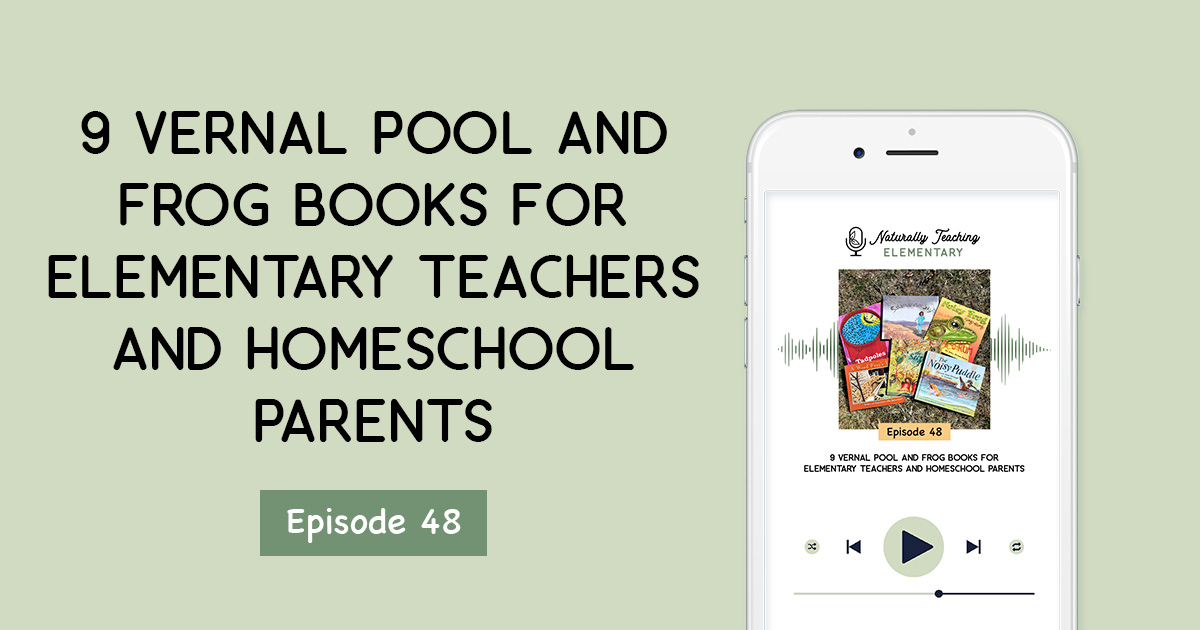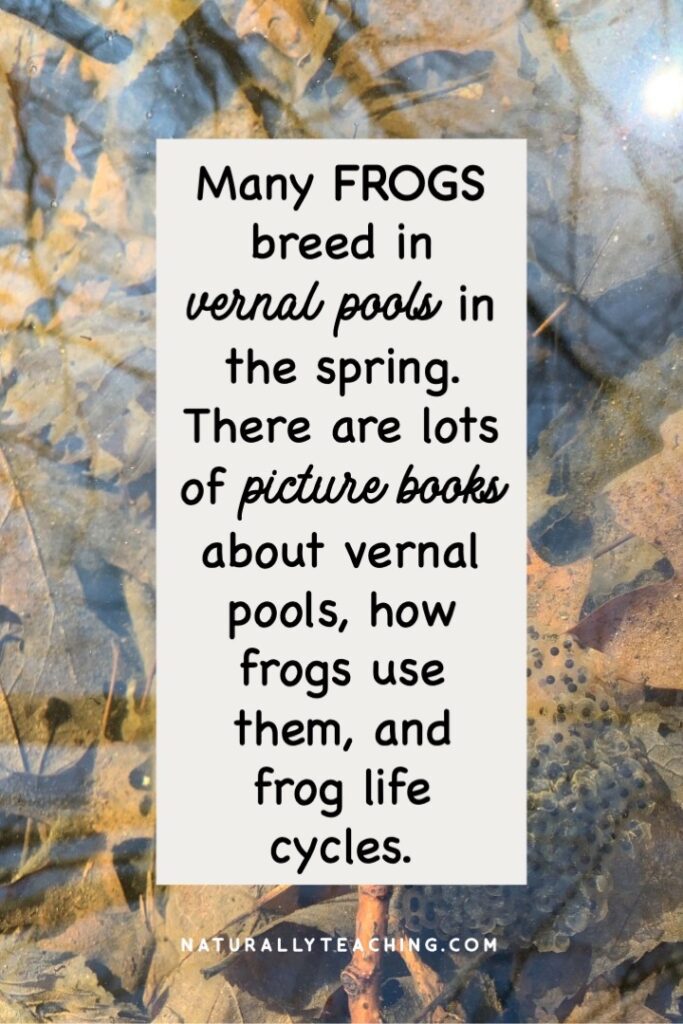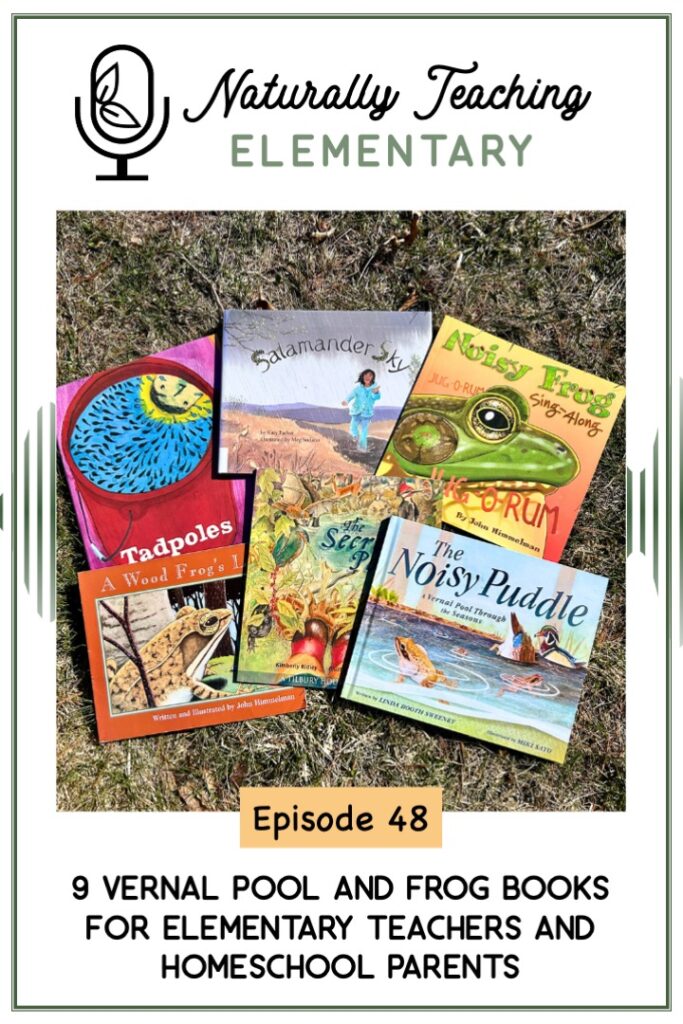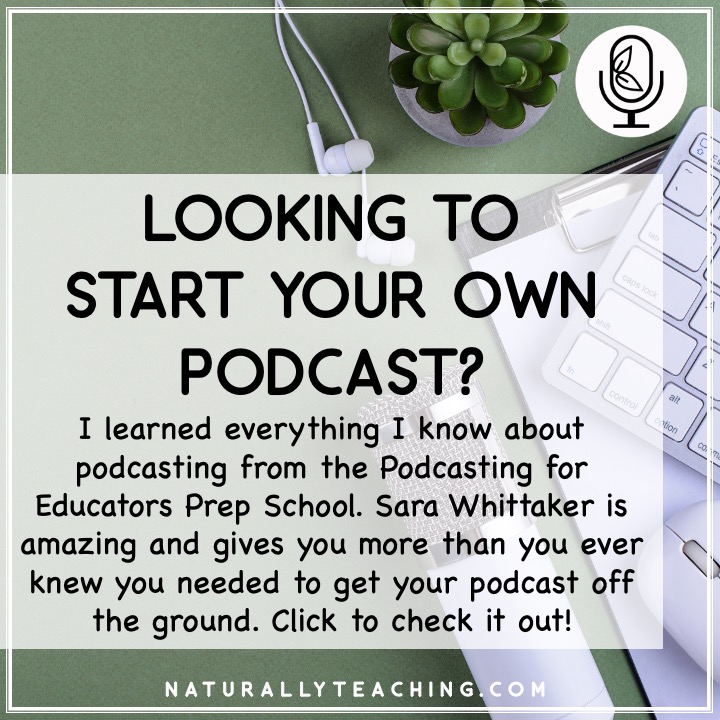Science
Frogs and Toads Together: Why do Amphibians Group Up?April 11, 2025


Affiliate disclosure: As an Amazon Associate, I may earn commissions from qualifying purchases from Amazon.com. This is at no extra cost to you. If you’d like to learn more, check out my disclaimers page.
Vernal pools are hopping, both literally and figuratively! This is the time of year when frogs and salamanders make their way to vernal pools to sing, dance, mate, and lay their eggs. To get your learners excited about this special time of the year, consider reading them vernal pool and frog books.
In this episode, I share 9 vernal pool and frog books that you can use in your elementary classroom and at home to introduce vernal pools, frogs that use them, and their life cycles. Listen in to discover some amazing vernal pool and frog books to use this school year.
Vernal pool and frog books covered in this episode include:
Vernal pools provide frogs more than just an escape from predators in the spring. They’re the closest body of water to their year-round habitat and that water is essential for the first three stages of their offspring’s life cycle. They also provide the perfect conditions for laying eggs for Wood frogs who lay their eggs in masses to maintain a certain temperature for development. Vernal pools also have a great source of food for tadpoles and froglets during their metamorphosis.

Affiliate Disclosure
I only endorse things that I’ve personally used, come highly recommended by trusted peers, or I’ve done extensive research on. As an Amazon Associate, I may earn commissions from qualifying purchases from Amazon.com. This is at no extra cost to you, the commission is covered by the company.
I am recommending products that I think will be genuinely helpful and useful, and not because of the small commissions that I receive. Please only purchase items if you believe that they will help you achieve your educational goals. If you’d like to learn more, check out my disclaimers page.
Teaching elementary-aged children is a rewarding experience, but as educators and parents, finding the time and resources to create engaging lessons can be a challenge. That's where this podcast comes in. Welcome to Naturally Teaching Elementary.
I'm Victoria Zablocki, a certified elementary teacher turned outdoor educator. With over a decade of experience coaching teachers on effective teaching methods, I'm passionate about teaching the whole child with authentic and place-based experiences in school and home settings. Join me as we explore our strategies for teaching with practical teaching tips, insightful interviews, picture book reviews, and more.
So let's grow together. Hey, everybody. Welcome back to the Naturally Teaching Elementary podcast. My name is Victoria Zablocki and I'm your host. So last week, we talked about activities for learning about vernal pools and frogs. I shared how these temporary wetlands are unique ecosystems that many animals, including frogs, rely on for their life cycles and survival.
I want to continue the conversation today by talking about vernal pool and frog books and how they can support your vernal pool explorations this spring.
[1:12]
But before we get into the episode, I wanted to share a nature note with more information about the connection between frogs and vernal pools. So last week, I kind of offhandedly mentioned that a lot of animals rely on vernal pools because they don't have fish and other large predators.
While this is very important, vernal pools do more than just that for frogs. Since frogs are amphibians, most of them lay their eggs in water where they'll hatch as tadpoles. Tadpoles eventually grow legs and then enter the froglet stage.
The first three stages of a frog's life rely fully on being in water, so vernal pools fit that bill. Some frogs use ponds or lakes, but vernal pools are the preferred choice of some species like Spring peepers and Chorus frogs. There are also some amphibian species that rely completely on vernal pools for their life cycles, and those are Wood frogs, Spotted salamanders, and Blue-spotted salamanders.
Scientists classify these three amphibians as obligate species for their dependence on this ecosystem. Part of the reason these three species are so dependent on vernal pools is the location. Spotted salamanders and Blue-spotted salamanders are mole salamanders, meaning they live in burrows in the forest.
Wood frogs also live in the forest in the leaf litter and under moist logs. So since all three of these species are forest dwellers, vernal pools are their closest body of water during the breeding season. But it's not just about proximity either.
Since vernal pools are made from snowmelt and rain, Wood frogs and Spotted salamanders don't have to wait for the water to thaw in the spring, like they would if they used ponds and lakes. These critters migrate to vernal pools when they feel the first spring rains, their first clue that their breeding grounds are ready. Vernal pools also provide ideal egg laying conditions for Wood frogs and Spotted salamanders.
Wood frogs lay their eggs in groups called rafts, which keeps them at the optimal temperature for developing. This technique could not be achieved in a large, permanent body of water during the same time of year. Later in the year, yes, but not the same time of the year.
Spotted and Blue-spotted salamanders lay their eggs attached to sticks and other vegetation sticking out of the water, and being in the forest, vernal pools provide the materials needed for attachment. Another reason Wood frogs and Spotted salamanders rely on vernal pools is that they are chucked full of food sources that their tadpoles and larvae eat while developing. And these are just a handful of ways that vernal pools benefit frogs and salamanders.
And although I could talk about this for hours, you came here to hear about picture books. So I'll leave you to investigate more on your own if you choose. So real quick, before we get into the books, I just wanted to note that if you've listened to my other episodes about picture books, I'm sure that you've caught on to the fact that I'm very passionate about teaching science concepts with the help of children’s literature.
And for good reason. Research has shown that integrating science and literacy has many benefits, including saving teachers time in their schedule, improved attitudes of children towards science, better overall performance in reading and science, and so many more.
For more information about benefits and methods for integrating science and literacy, check out my blog post “Teaching with Books: How to Integrate Science and Literacy for Elementary Classrooms.” All right, now let's get into these vernal pool and frog books.
[4:23]
So book number one is The Secret Pool by Kimberly Ridley, illustrated by Rebekah Raye. And if you listened to last week's episode, you heard me talk about this book.
And this book is an absolute treasure. Ridley shares what a vernal pool is by anthropomorphizing a vernal pool and letting it tell its seasonal experiences firsthand. Starting in the spring, the vernal pool mentions different animals that come to its waters, including wood frogs and spotted salamanders.
It also shares how it shrinks throughout the year and will return again the next spring when the snow melts and the rain falls. This book is one of my absolute favorite spring books and includes so much goodness. On each page, Ridley includes part of the beautiful narrative, but then she also includes an inset to describe the science behind what's happening with each topic.
Thanks to the combination of storyline and facts, this book can provide you and your learners all the background information you'll need to get started exploring vernal pools today. It's also great to use with any elementary-age learner since you can scaffold the amount of information you share with them. And I can't forget to mention that the illustrations by Rebekah Raye are lovely and perfectly capture the unique critters that call vernal pools home.
[5:32]
Book number two is The Noisy Puddle: A Vernal Pool Through the Seasons by Linda Booth Sweeney, illustrated by Miki Sato. This is a new to me book, and I'm so glad that I found it. Written in rhythm and rhyme, Sweeney shares how a vernal pool transforms throughout the year.
Following two children exploring nature, the story begins in spring with some examples of animals that use the vernal pools, including Spring peepers, Wood frogs, Fairy shrimp, and Spotted salamanders. As the year goes on, the children find that the vernal pool dries up and disappears, but there are organisms still using the space, including Button bush and butterflies that eat from the Button bush flowers. Next is autumn, where the leaves fall onto the forest floor and add to the leaf litter that will be part of the vernal pool in the spring.
Then in winter, the vernal pool animals lay waiting underground for the spring rain, including Fairy shrimp eggs, Caddisflies, frogs, and salamanders. It ends with the return of the vernal pool in the spring. This book is a great simplistic overview of what a vernal pool is.
Comparing the vernal pool to a puddle alongside the rhythm and rhyme can grab the attention of early childhood learners. The focus on seasons is also great for those early childhood learners. The storyline is simple and to the point and includes a great overview of animals that use the vernal pools, but I find that the illustrations by Miki Sato are the star in this book.
Sato uses a cut paper collage style of illustrating with an incredible attention to detail. The depiction of the progression of the salamander eggs is truly amazing. If you get a hold of this book, make sure to pay very close attention to all of the pictures. They'll tell you amazing things.
[7:08]
Book number three is Vernal Pool Visitors by Heidi Clemmer, illustrated by Marissa Picariello. This book is placed in the Cape Cod area and starts with the migration of Spadefoot toads.
Clemmer shares what a vernal pool is and how they're created in the spring from snowmelt and rain. The Spadefoot toads have to cross a road to the forest where the vernal pools are, and a ranger ends up helping them cross. There are other vernal pool animals shared in the story line, including Spotted salamanders and Fairy shrimp.
And the story ends with the coming of summer when the vernal pools are dried up, the Wood frogs are sleeping, the Spotted salamanders are back in their burrows, and the Spadefoot toads dig themselves underground homes to await the next breeding season. This book is nice because it gives the readers a look at a lesser known species of amphibian that relies on vernal pools. Most books that mention vernal pools focus on Wood frogs or Spotted salamanders, but this one shines the spotlight on Spadefoot toads.
It's also nice that this book is placed at the Cape Cod area. A lot of other books are generic and not place-based. So, if you are in Massachusetts, this would be a great option to read to your learners.
It is short and sweet, so it would probably be best for early childhood learners, but you could also read it to upper elementary age children if you wanted a quick read. And as a bonus for this book, there's a video on YouTube of the author reading it. It's nice for your learners to hear the author read aloud their work, and you can give them this opportunity from the comfort of your classroom or home. And I'll make sure to put a link for it in the show notes.
[8:35]
Book number four is A Wood Frog's Life by John Himmelman. This book is all about the life of a wood frog. It starts with a group of eggs being laid in a vernal pool and then eggs hatch. A male tadpole eats some algae, grows some legs and then emerges from the water. He hunts for small insects and moves away from the vernal pool and into the forest.
He spends the summer eating and then he uses fall to get ready for winter. After sleeping all winter, he wakes up in the spring and looks for a vernal pool to sing to female wood frogs. He spends the summer looking for food and then he finds a place to sleep for the winter.
When spring rolls around again, he returns to the vernal pools and attracts a female. They mate and lay eggs and he continues his life throughout the seasons. This book is a great example of the relationship between vernal pools and frogs.
The cyclical nature of the story line shows life cycles and how the seasons determine the behavior of animals. And if you're looking to introduce life cycles, animal needs, vernal pools and more, this is a great option for you to share with your learners.
[9:32]
Book number five is Tadpoles by Matt James. And this book is about a vernal pool that's created not in a forest but in a field. Although less common, there are temporary pools created in fields that can support very similar species to their forest counterparts. The story begins with a child talking about everyday kid things like a classmate saying they saw a frog with two heads and that the field used to be a dump.
The storyline continues as the child shares observations and life experiences, including fear that their recently separated father won't love them anymore now that he's moved to his new home. The child goes on to share experiences in the field, including finding eggs and tadpoles in the ephemeral or vernal pool. The story ends with the child catching and releasing tadpoles in the pool in the field.
This book shares the different life stages of frogs and shares a different word for vernal pools, ephemeral pools. Although it's not my favorite book on this list, it has great vocabulary for young learners. I find all the scientific information helpful for introducing the frog life cycle as well as vernal pools, but I find the storyline a bit choppy.
It is nice that this book provides the perspective that some vernal pools can be found in fields, whereas most books are about vernal pools in forests.
[10:42]
Book number six is Noisy Frog Sing-Along by John Himmelman. This book is all about frogs singing from water. The story begins with an explanation of why male frogs sing and how it helps them attract females for egg laying.
Himmelman shares the species name and onomatopoeia words that sound like the call of the frogs. Species included in the story are Spring peepers, Green frogs, toads, Bullfrogs, Pickerel frogs, Chorus frogs, Mink frogs, Spadefoot toads, and tree frogs.
This book is a fun way to introduce how frogs call in the spring to find mates to lay eggs. The pages encourage the reader to make the frog sounds, and the pictures include the role of water during the breeding season. As a bonus, at the back of the book, Himmelman includes descriptions of each of the frog species, ideas for activities to do with your learners, and a link to a webpage that includes recordings of the different frogs mentioned throughout the book, which is a really nice addition.
[11:35]
Book number seven is The Salamander's Life by John Himmelman. This book is all about the life of a Spotted salamander. It starts with a female Spotted salamander laying her eggs in water in spring.
Then the eggs hatch and a salamander larva makes her way away from the egg mass and finds a copepod to eat. She grows legs and absorbs her external gills. And at the end of the summer, she leaves the pond and hunts for insects, moving farther into the forest.
When the weather turns cold, she looks for a burrow to sleep for the winter. And then when spring comes and the rain enters the burrow, she wakes up and migrates with a bunch of other Spotted salamanders. She enters the vernal pool and finds a mate and lays her own eggs.
Then she returns to the forest and continues the cycle through the seasons. Much like A Wood Frog's Life, this book is a great example of the relationship between vernal pools and salamanders. The cyclical nature of the storyline shows life cycles and how the seasons determine the behavior of animals.
If you're looking to introduce life cycles, animal needs, vernal pools and more, this is another great option for you to share with your learners. And if you hadn't noticed, a third of this list was written by John Himmelman. He's a fantastic naturalist author and illustrator.
If you like A Wood Frog's Life or A Salamander's Life, then you'll be happy to hear that it's part of his Nature Upclose series. I wrote an article called “11 Fantastic Animal Life Cycles Books” by John Himmelman that shows off all the different books from this series. Not only does he cover life cycles, he also shares predator and prey relationships, animal needs, animal habitat, and more in these fantastic narratives. I'll make sure to put a link for that article in the show notes, so you can check all these books out.
[13:08]
Book number eight is Salamander Sky by Katy Farber, illustrated by Meg Sodano. This book is about a little girl named April whose mom is a scientist. April's mother shares the story of the migrating Spotted salamanders with her, and she's excited to help the salamanders make their way to the vernal pools. April shares descriptions of where Spotted salamanders can be found in summer and fall and how they indicate the health of ecosystems. She also shares how pollution, roads, buildings and climate change negatively affect the salamanders’ populations.
After a day of nonstop rain, her mom tells her that tonight is the night that the salamanders are migrating, and she gets on her gear to go out and help the salamanders. Her and her mom search a road and help salamanders get across safely. This book is a beautiful story about conservation and stewardship.
By sharing the benefits of salamanders to the biosphere and ways that people can help keep them safe, this can empower your learners to look for ways to help these amazing creatures thrive. In a roundabout way, this book also shares weather conditions of spring, the life cycle of salamanders, animal needs, and how vernal pools are beneficial to amphibians. And as if this book wasn't amazing already, Sodano chose to illustrate a family of minority, helping all students see themselves as scientists and people that care for animals.
[14:22]
Book number nine is Salamander Season by Jennifer Keats Curtis and J. Adam Frederick, illustrated by Shennen Bersani. This book is a journal of a child's experience with Spotted salamanders.
The young girl and her father visit a vernal pool multiple times over the breeding and growing season so that her father, a scientist, can study the development. As her dad observes the salamanders in his lab, they change from tadpole-looking creatures to growing hind legs and reabsorbing their external gills. When they start to look like little salamanders, the dad and daughter take the salamanders back to the forest and release them to the wild.
This book is a nice way to view the Spotted salamander life cycle and how much time it could take for them to progress through their life stages. There's also illustrations and photographs showing the progression not just with drawings but also with real life depictions.
The combination of vocabulary and photographs makes this book a fantastic read for upper elementary age children but could benefit early childhood learners too. It's also a lovely example of science notebooking since there's diagramming and photographs and notes all over each page.
[15:28]
So in a nutshell, we talked about nine vernal pool and frog books to support your vernal pool explorations this month. Titles that were summarized include The Secret Pool by Kimberly Ridley, illustrated by Rebekah Raye.
The Noisy Puddle: A Vernal Pool Through the Seasons by Linda Booth Sweeney, illustrated by Miki Sato. Vernal Pool Visitors by Heidi Clemmer, illustrated by Marissa Picariello. A Wood Frog's Life by John Himmelman.
Salamander Sky by Katy Farber, illustrated by Meg Sodano. And Salamander Season by Jennifer Keats Curtis and J. Adam Frederick, illustrated by Shennen Bersani.
And if you're fired up about teaching frog life cycles after listening to this list, check out my Frog Life Cycle and Grouping Mini Unit for 3rd grade. This mini unit includes made-for-you ELA and science activities aligned with the Common Core State Standards and the Next Generation Science Standards. It includes a suggested picture book list as well as activities that compare with almost any picture book about frog life cycles, so those on this list and others.
These activities include answering key questions about the text, science vocabulary by sentence context, an informative writing, modeling the life cycle of a frog and salamander, a short research project about why amphibians group together, a short research project about a local frog species, collecting weather data, and designing a frog life cycle. So I want to thank you for taking time to listen today. I know you're busy, and I truly appreciate the time you take to tune in.
If you have any questions, wonderings, or vernal pool and frog books that you like to read, get ahold of me on Instagram at naturally.teaching, or you can email me at victoria at naturallyteaching.com. And don't forget to check out the show notes for this episode at naturallyteaching.com/episode48, where I'll have all the links to the articles, resources, and the YouTube video for the reading of Vernal Pool Visitors. So thanks again for joining me today, and until next time, keep exploring, keep learning, and keep naturally teaching.
Thank you so much for tuning in to today's episode of the Naturally Teaching Elementary Podcast. I hope you found it informative, inspiring, and full of actionable insights to enhance your teaching journey. Connect with me on social media for more updates, science tidbits, and additional resources.
You can find me on Instagram and Facebook at naturally.teaching. Let's continue the conversation and share our passion for teaching elementary age children together. Don't forget to visit my website at naturallyteaching.com for all the show notes from today's episode.
If you enjoyed today's episode, please consider leaving a review on your favorite podcast platform. Your feedback helps me improve and reach more educators like you. Thank you again for listening. And until next time, keep exploring, keep learning, and keep naturally teaching.


0